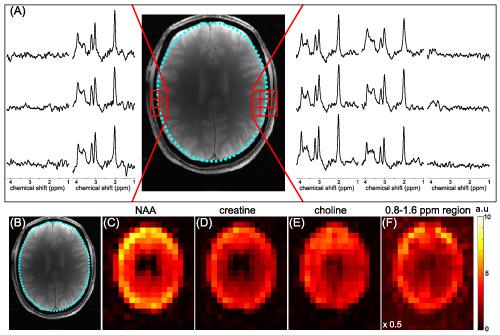当前位置:
X-MOL 学术
›
NMR Biomed.
›
论文详情
Our official English website, www.x-mol.net, welcomes your feedback! (Note: you will need to create a separate account there.)
ECLIPSE utilizing gradient‐modulated offset‐independent adiabaticity (GOIA) pulses for highly selective human brain proton MRSI
NMR in Biomedicine ( IF 2.9 ) Pub Date : 2020-10-01 , DOI: 10.1002/nbm.4415 Chathura Kumaragamage 1 , Henk M De Feyter 1 , Peter Brown 1 , Scott McIntyre 1 , Terence W Nixon 1 , Robin A de Graaf 1, 2
NMR in Biomedicine ( IF 2.9 ) Pub Date : 2020-10-01 , DOI: 10.1002/nbm.4415 Chathura Kumaragamage 1 , Henk M De Feyter 1 , Peter Brown 1 , Scott McIntyre 1 , Terence W Nixon 1 , Robin A de Graaf 1, 2
Affiliation

|
A multitude of extracranial lipid suppression methods exist for proton MRSI acquisitions. Popular and emerging lipid suppression methods each have their inherent set of advantages and disadvantages related to the achievable level of lipid suppression, RF power deposition, insensitivity to B1+ field and lipid T1 heterogeneity, brain coverage, spatial selectivity, chemical shift displacement (CSD) errors and the reliability of spectroscopic data spanning the observed 0.9‐4.7 ppm band. The utility of elliptical localization with pulsed second order fields (ECLIPSE) was previously demonstrated with a greater than 100‐fold in extracranial lipid suppression and low power requirements utilizing 3 kHz bandwidth AFP pulses. Like all gradient‐based localization methods, ECLIPSE is sensitive to CSD errors, resulting in a modified metabolic profile in edge‐of‐ROI voxels. In this work, ECLIPSE is extended with 15 kHz bandwidth second order gradient‐modulated RF pulses based on the gradient offset‐independent adiabaticity (GOIA) algorithm to greatly reduce CSD and improve spatial selectivity. An adiabatic double spin‐echo ECLIPSE inner volume selection (TE = 45 ms) MRSI method and an ECLIPSE outer volume suppression (TE = 3.2 ms) FID‐MRSI method were implemented. Both GOIA‐ECLIPSE MRSI sequences provided artifact‐free metabolite spectra in vivo, with a greater than 100‐fold in lipid suppression and less than 2.6 mm in‐plane CSD and less than 3.3 mm transition width for edge‐of‐ROI voxels, representing an ~5‐fold improvement compared with the parent, nongradient‐modulated method. Despite the 5‐fold larger bandwidth, GOIA‐ECLIPSE only required a 1.9‐fold increase in RF power. The highly robust lipid suppression combined with low CSD and sharp ROI edge transitions make GOIA‐ECLIPSE an attractive alternative to commonly employed lipid suppression methods. Furthermore, the low RF power deposition demonstrates that GOIA‐ECLIPSE is very well suited for high field (≥3 T) MRSI applications.
中文翻译:

ECLIPSE 利用梯度调制的与偏移无关的绝热 (GOIA) 脉冲进行高选择性人脑质子 MRSI
质子 MRSI 采集存在多种颅外脂质抑制方法。流行和新兴的脂质抑制方法各有其固有的一组优点和缺点,这些优点和缺点与可达到的脂质抑制水平、射频功率沉积、对 B 1 +场和脂质 T 1的不敏感性有关异质性、大脑覆盖率、空间选择性、化学位移位移 (CSD) 误差以及跨越观察到的 0.9-4.7 ppm 波段的光谱数据的可靠性。使用脉冲二阶场 (ECLIPSE) 的椭圆定位的实用性先前已被证明具有超过 100 倍的颅外脂质抑制和使用 3 kHz 带宽 AFP 脉冲的低功率要求。与所有基于梯度的定位方法一样,ECLIPSE 对 CSD 错误很敏感,从而导致 ROI 边缘体素中的代谢曲线发生改变。在这项工作中,ECLIPSE 基于梯度偏移无关绝热 (GOIA) 算法扩展了 15 kHz 带宽二阶梯度调制射频脉冲,以大大降低 CSD 并提高空间选择性。实施了绝热双自旋回波 ECLIPSE 内体积选择 (TE = 45 ms) MRSI 方法和 ECLIPSE 外体积抑制 (TE = 3.2 ms) FID-MRSI 方法。两个 GOIA-ECLIPSE MRSI 序列都提供了体内无伪影代谢物光谱,脂质抑制大于 100 倍,平面内 CSD 小于 2.6 mm,ROI 边缘体素的过渡宽度小于 3.3 mm,代表与母体非梯度调制方法相比,改进了约 5 倍。尽管带宽增加了 5 倍,但 GOIA-ECLIPSE 只需要增加 1.9 倍的射频功率。高度稳健的脂质抑制与低 CSD 和锐利的 ROI 边缘过渡相结合,使 GOIA-ECLIPSE 成为常用脂质抑制方法的有吸引力的替代方案。此外,
更新日期:2020-12-08
中文翻译:

ECLIPSE 利用梯度调制的与偏移无关的绝热 (GOIA) 脉冲进行高选择性人脑质子 MRSI
质子 MRSI 采集存在多种颅外脂质抑制方法。流行和新兴的脂质抑制方法各有其固有的一组优点和缺点,这些优点和缺点与可达到的脂质抑制水平、射频功率沉积、对 B 1 +场和脂质 T 1的不敏感性有关异质性、大脑覆盖率、空间选择性、化学位移位移 (CSD) 误差以及跨越观察到的 0.9-4.7 ppm 波段的光谱数据的可靠性。使用脉冲二阶场 (ECLIPSE) 的椭圆定位的实用性先前已被证明具有超过 100 倍的颅外脂质抑制和使用 3 kHz 带宽 AFP 脉冲的低功率要求。与所有基于梯度的定位方法一样,ECLIPSE 对 CSD 错误很敏感,从而导致 ROI 边缘体素中的代谢曲线发生改变。在这项工作中,ECLIPSE 基于梯度偏移无关绝热 (GOIA) 算法扩展了 15 kHz 带宽二阶梯度调制射频脉冲,以大大降低 CSD 并提高空间选择性。实施了绝热双自旋回波 ECLIPSE 内体积选择 (TE = 45 ms) MRSI 方法和 ECLIPSE 外体积抑制 (TE = 3.2 ms) FID-MRSI 方法。两个 GOIA-ECLIPSE MRSI 序列都提供了体内无伪影代谢物光谱,脂质抑制大于 100 倍,平面内 CSD 小于 2.6 mm,ROI 边缘体素的过渡宽度小于 3.3 mm,代表与母体非梯度调制方法相比,改进了约 5 倍。尽管带宽增加了 5 倍,但 GOIA-ECLIPSE 只需要增加 1.9 倍的射频功率。高度稳健的脂质抑制与低 CSD 和锐利的 ROI 边缘过渡相结合,使 GOIA-ECLIPSE 成为常用脂质抑制方法的有吸引力的替代方案。此外,



























 京公网安备 11010802027423号
京公网安备 11010802027423号